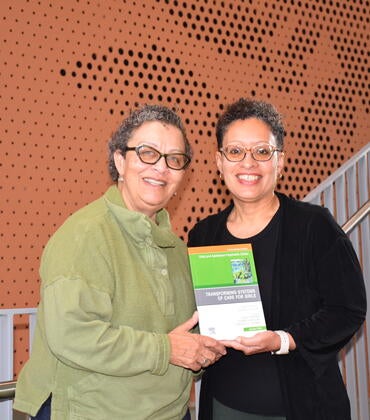
The U.S. Senate passed a bill on March 15 that would make daylight saving time permanent. It was approved by consent – and some are framing this procedural move as an “end run," as many senators said they were surprised by the vote. The measure still has to pass the House, where it is parked for now. President Biden would have to sign the shift into law.
Kevin Esterling, a UC Riverside professor of political science and public policy, this week assessed the bill's chances in the House as bleak. "I find it extremely unlikely that the legislation will pass in the House," he said. "The members are saying that they need time to research it before making a decision, and the longer they wait, the more controversial it’s going to be to make daylight saving permanent. Farmers, educators, and constituents who are parents will have time to lodge their complaints, and members in the House will find it easier just to let the legislation die."
To gauge the impacts of dark mornings in some parts of the country, including on school-age children, we spoke with Dr. Michael Ingram, an assistant professor of psychiatry in the School of Medicine, and Stephanie Moore, a licensed psychologist, certified school psychologist, and assistant professor in the School of Education.
What are the effects on children of daylight vs. darkness?
Stephanie Moore: An important caveat in this discussion is, as stated by the American Academy of Sleep Medicine, or AASM, that “chronic effects of remaining in daylight saving time year-round have not been well studied.”
Daylight and darkness are important in regulating the body’s circadian rhythm, which influences a host of biological processes including the sleep-wake cycle, alertness, and cognitive performance (Beute & de Kort, 2013), which may have implications for children’s functioning. Morning daylight is important in helping children and adults to wake up and feel alert, whereas evening darkness is important in stimulating melatonin, which supports sleep (Malow, 2022).
Light exposure also has implications for mood, for example, with limited daylight in winter months being implicated in seasonal affective disorder, although seasonal affective disorders are more common in adults than in children. In their recent position statement, the AASM argue that standard time is best aligned with circadian rhythms and is likely most beneficial for health and safety.
What is seasonal affective depressive disorder and why is it more common/pronounced after we move our clocks forward and back?
Michael Ingram: Seasonal affective disorder, or SAD, is a form of depression that most often occurs during the fall and winter months when daylight hours are shortened. SAD is not just “winter blues,” as symptoms can significantly interfere with daily functioning.
Symptoms of SAD include feeling very tired, sleeping too much, overeating (cravings for carbohydrate-rich foods), feeling sad or depressed, lack of interest or pleasure in previously pleasurable activities, low motivation, acting withdrawn, restlessness, concentration problems, indecisiveness, and, if severe, thoughts of death or suicide.
Generally, SAD is more common among women than men and affects approximately 5% of adults in the United States. Symptoms usually improve in the early spring and summer months, although a small percentage of individuals experience SAD symptoms during the summertime. Not surprisingly, SAD is more common in people who live further from the equator, where daylight hours are much shorter during the winter months.
The prevailing hypothesis for why SAD occurs relates to our internal biological clock, also called our circadian rhythm. Our circadian rhythm directs our sleep-wake cycle, our mood, our appetite, our hormone levels, and other important functions. An abrupt change in daylight hours may perturb our rhythm and cause our brains to be “out-of-tune.” In other words, as the duration of daylight hours changes, people can experience a shift in their internal clocks, which interferes with daily routines.
If we stopped moving our clocks twice each year, might we see fewer cases of seasonal affective depressive disorder?
Michael Ingram: Although there are no studies that prove a causal link between daylight savings and depression, there are studies that show associations between daylight saving time transitions and increased incidence of depressive episodes. While it makes sense theoretically, more research is needed.
Based upon what we know, it is plausible that eliminating daylight savings would result in fewer cases of seasonal affective disorder.
Which schoolchildren will this change affect positively and/or negatively the most?
Stephanie Moore: Regarding children and adolescents, research attention has previously been directed to the impact of school start times on adolescents. In contrast to younger children, middle and high school age children have shifted circadian cycles, such that they tend to fall asleep and wake up later—which present a challenge in the context of early school start times.
Data from the National Center for Education Statistics indicated that in the 2017-18 school year, the average high school start time was 8 a.m., with 42% of high schools beginning before 7:59 am. You might recall a story popular in the news in 2018 about Seattle schools that shifted their students’ high school start times back by one hour. Results from this research found that, after delaying school start times, students were getting on average 34 minutes more sleep per night and schools reported improvements in student grades and attendance, indicating that aligning school start times more closely with teens sleep-wake cycles can have positive impacts on their education.
Thus, if the shift to permanent daylight saving time is made, it seems pertinent for middle and high schools, in particular, to consider shifting their start times accordingly.
How can the effects of seasonal affective depressive disorder be minimized?
Michael Ingram: Fortunately, there are effective strategies for alleviating symptoms of SAD. The first thing to do is create a routine and stick to it. Behavioral strategies such as daily exercise, a healthy, well-balanced diet rich in Vitamin D, and a consistent sleep routine are helpful for many people. Humans are creatures of habit, so going to sleep and waking up at the same time each day is crucial to maintain the integrity of our circadian cycles. Talk therapy can also be very helpful.
Many people have benefited from happy lamps or happy lights, which are special lamps that mimic natural sunlight. However, it is important to consult with your physician before trying this as it can make some psychiatric disorders worse. Medications are usually a last resort, but the most studied medication for this indication is the noradrenergic-dopamine reuptake inhibitor, bupropion (Wellbutrin).



